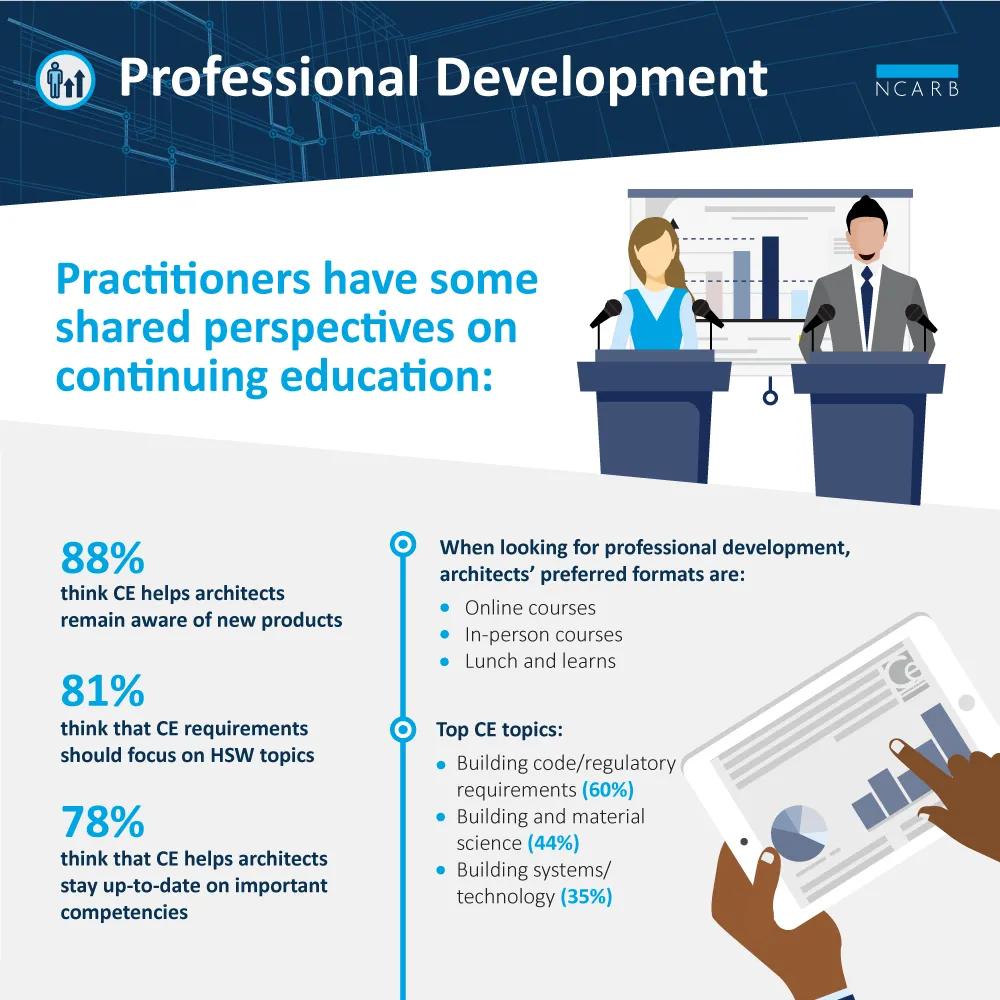In most states, architects are required to earn continuing education (CE) every year to ensure their ongoing professional development—an important step in maintaining competency post-licensure. To better understand the value of professional development, the ways architects consume CE materials, and opportunities for improvement, NCARB surveyed thousands of architects and other practitioners as part of our 2022 Analysis of Practice Study.

Ensuring Competency
Most respondents believed continuing education is an important part of the licensure framework, ensuring that architects stay up-to-date with the latest trends, technologies, and advancements in practice.
- 88% of respondents think continuing education helps architects remain aware of new products
- 78% think that CE helps architects stay up-to-date on important competencies
- 68% think CE promotes innovation and advancement
Opportunities for Improvement
However, respondents also thought that there were several ways to improve CE offerings and requirements:
- 81% think CE requirements should focus on health, safety, and welfare topics
- 61% think CE programs should offer more rigorous content
Delivery and Workplace Support
When asked about preferred methods of CE delivery, responses preferences were split across five common formats: online courses, in-person courses, lunch and learns, webinars, and conferences. However, respondents’ employers most frequently supported lunch and learns and webinars.
Additionally, respondents indicated that both they and their workplace appreciated opportunities to network with colleagues and learn from vendors or product representatives.
Beneficial CE Topics
When respondents were asked to indicate the CE topics that were most beneficial, the top five included:
- Building code/regulatory requirements
- Building and material science
- Building systems/technology
- Accessibility/universal design
- Construction means and methods
However, there were some notable differences for various demographic groups.
Demographic Differences
- Sustainability and Resiliency: Younger professionals were more likely to indicate that CE on topics related to sustainability and resiliency were beneficial compared to older, more experienced practitioners.
- Workplace size: Larger workplaces were more likely to support a wider variety of opportunities for training and professional development compared to smaller employers.
- Leadership Programs: Women were more likely than men to find leadership programs beneficial.
What’s Next?
Over the coming years, NCARB will be exploring the next iteration of the licensure process—including ways to ensure competency post-licensure. Findings from the Analysis of Practice will inform what post-licensure requirements will look like in the years ahead. We look forward to sharing more insights from other sections of the Analysis of Practice with you in the months ahead.
About the Analysis of Practice
In 2022, over 19,000 individuals across the architecture, engineering, and construction (AEC) industry participated in NCARB’s once-in-a-decade Analysis of Practice study. Through a series of short questionnaires, focus groups, a final extensive survey, and more, NCARB gathered key insights about the field of architecture that will help shape the licensing model of the future.
Results from the study will help us better understand the ecosystem of architectural practice and may lead to changes to NCARB’s national licensing programs and standards of the future.


